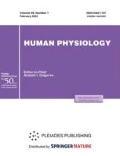Abstract
The structural and functional characteristics of the heart of 51 retired soccer players who ceased training 3–15 years ago are presented. A number of structural and functional signs of “athlete’s heart” detected in the subjects indicate more efficient heart functioning at rest and during exercise. The myocardium requires less oxygen per unit power of muscle work, and each gram of the myocardium of retired athletes performs more mechanical work than the myocardium of untrained subjects of the same age. This indicates long-term adaptation of the heart of retired athletes to muscle work. The heart functioning at rest and during exercise in retired athletes becomes less efficient with age, this trend being more pronounced in older former athletes than in younger ones. This is expressed in an increased oxygen consumption by the myocardium, a higher occurrence of atypical electrocardiogram patterns, age-related changes in myocardial contractility, and a decreased capacity of each gram of the myocardium for generating mechanical work.
Similar content being viewed by others
References
Motylyanskaya, R.E., Sport i vozrast (Sports and Age), Moscow: Medgiz, 1956.
Graevskaya, N.D., Vliyanie sporta na serdechno-sosudistuyu sistemu (Effect of Sports on the Cardiovascular System), Moscow: Meditsina, 1975.
Graevskaya, N.D., Lazareva, I.A., Savinskii, V.N., and Belakovskii, O.M., Health and Functional Capacities of the Body of Retired Athletes Long after the Cessation of Training, Vestn. Sport. Med. Rossii, 1993, nos. 2–3, p. 14.
Jager, M., La mort subite dans la pratigue du sport. Commenten reduire l’incidence?, Cardiol. Angeol., 1990, vol. 39, p. 565.
Maron, B.J. and Klues, H.G., Surviving Competitive Athletics with Hypertrophic Cardiomyopathy, Am. J. Cardiol., 1994, vol. 73, part 15, no. 6, p. 1098.
Hawkins, S.A., Wiswell, R.A., and Marcell, N.J., Exercise and the Master Athlete: A Model of Successful Aging?, J. Gerontol. Biol. Sci. Med. Sci., 2003, vol. 58, no. 11, p. 1009.
Kujala, U.M., Marti, P., Kaprio, J., et al., Occurrence of Chronic Disease in Former Top-Level Athletes: Predominance of Benefits, Risks or Selection Effects?, Sports Med., 2003, vol. 33, no. 8, p. 553.
Kushakovskii, M.S., Gipertonicheskaya bolezn’ i vtorichnye arterial’nye gipertenzii (Essential Hypertension and Secondary Arterial Hypertensions), Moscow: Meditsina, 1982.
Kushakovskii, M.S., Metabolichekie bolezni serdtsa (Metabolic Diseases of the Heart), St. Petersburg: Foliant, 2000.
Safronov, V.V., Kuz’michev, Yu.G., Madzgvarishvili, R.A., et al., Age-Related Characteristics of the Main Echocardiographic Parameters, Fiziol. Chel., 1980, no. 5, vol. 6, p. 813.
Zaretskii, V.V., Bobkov, V.V., and Ol’binskaya, L.I., Klinicheskaya ekhokardiografiya: Atlas (Atlas of Clinical Echocardiography), Moscow: Meditsina, 1979.
Mukharlyamov, N.N. and Belenkov, Yu.N., Ul’trazvukovaya diagnostika v kardiologii (Ultrasound Diagnosis in Cardiology), Moscow: Meditsina, 1981.
Graevskaya, N.D., Goncharova, G.A., and Kalugina, G.E., Heart Echocardiographic Study in Athletes, Kardiologiya, 1978, vol. 18, no. 2, p. 140.
Kalugina, G.E., Morphological and Functional Characteristics of the “Athlete’s Heart” (Based on Ultrasound Cardiographic Data), Doctoral (Med.) Dissertation, Moscow, 1984.
Belotserkovskii, Z.B. and Karpman, V.L., Possibilities Offered by Echocardiography and Prospects of Its Use in Sports Medicine, Teor. Prakt. Fiz. Kul’t., 1991, no. 7, p. 2.
Komadel, L., Barta, E., and Kokavets, M., Fiziologicheskoe uvelichenie serdtsa (Physiological Hypertrophy of the Heart, Bratislava: Slov. Akad. Nauk, 1968.
Guyton, A.C., Cardiac Output and Its Regulation, Philadelphia: W.B. Saunders, 1963.
Guyton, A.C., Minutnyi ob"em serdtsa i ego regulyatsiya (Cardiac Output and Its Regulation), Moscow: Meditsina, 1969.
Chebotarev, D.F. and Frol’kis, V.V., Serdechno-sosudistaya sistema pri starenii (The Cardiovascular System and Aging), Leningrad: Meditsina, 1967.
Korkushko, O.V., Klinicheskaya kardiologiya v geriatrii (Clinical Cardiology in Geriatrics), Moscow: Meditsina, 1980.
Tokar’, A.V., Arterial’naya gipertoniya i vozrast (Arterial Hypertension and Age), Kiev: Zdorov’ya, 1977, p. 143.
Blair, S.N., Kohe, H.W., Poffenbarger, R.S., et al., Physical Fitness and All-Cause Mortality and Perspective Study of Healthy Men and Women, JAMA, 1989, vol. 262, p. 2395.
Author information
Authors and Affiliations
Additional information
Original Russian Text © Z.B. Belotserkovskii, B.G. Lyubina, A.V. Smolenskii, V.V. Sagitova, O.V. Kozyreva, E.V. Bogdanova, 2007, published in Fiziologiya Cheloveka, 2007, Vol. 33, No. 4, pp. 119–125.
Rights and permissions
About this article
Cite this article
Belotserkovskii, Z.B., Lyubina, B.G., Smolenskii, A.V. et al. Structural and functional characteristics of the heart of professional soccer players after retirement from long-term sports activity. Hum Physiol 33, 490–495 (2007). https://doi.org/10.1134/S0362119707040172
Received:
Issue Date:
DOI: https://doi.org/10.1134/S0362119707040172




